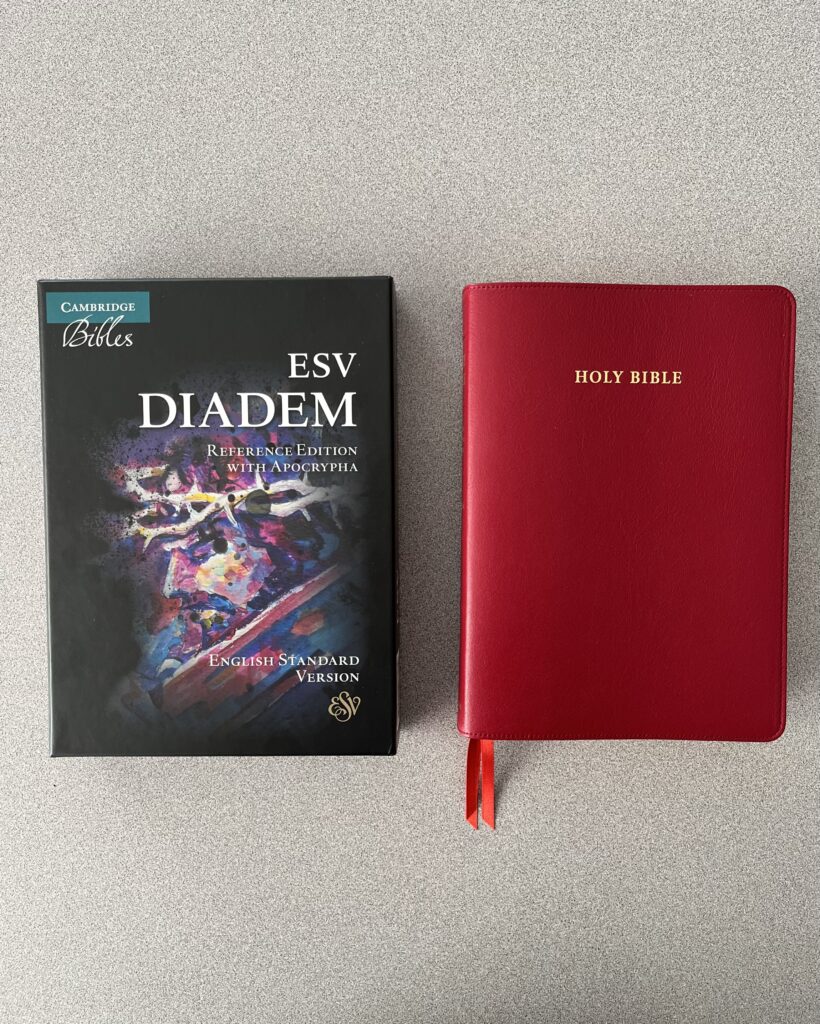
One of my first entries for The Catholic Bibles Blog was titled “Catholic Bibles Stink!” It was not directed so much at the translations that were available at the time, but rather the overall lack of quality in the available editions and the absolute lack of any premium Catholic editions. The date of that blog post was September 14, 2008. Since the publication of that post (almost 14 years ago!), there have been some interesting developments. While the hoped for Catholic-specific premium bible still remains elusive, a number of truly fantastic editions that any Catholic could utilize have been published. The two most notable would be the Cambridge NRSV Reference Bible w/Apocrypha (2018) and the Schuyler Quentel RSV w/ Apocrypha (2021). Both of them are truly fantastic editions, made with the utmost quality materials and containing useful content in a readable format. If you can get over the fact that they aren’t properly “Catholic Editions” then you can’t go wrong with either of these editions. I highly recommend both of them. And while there are some nice Catholic bibles out there, most notably from Baronius Press and Catholic Bible Press, they are not in the same league as the Cambridge and Schuyler. Not even close. But there is hope! I am excited to report that I would add another edition to this list. Cambridge’s ESV Diadem w/Apocrypha easily takes a seat at the table right alongside the Cambridge NRSV and the Schuyler RSV.
Although Oxford published the ESV w/Apocrypha in a hardcover edition right around the time I first wrote “Catholic Bibles Stink!”, I would never have guessed that there would be not only a fully Catholic edition of the ESV, but it would also be approved for liturgical use. In the USA, the ESV has the full support of the Augustine Institute, which has not only made it their bible of choice but also has published some nice editions already with the promise of more to come. In the UK, SPCK has their own line of editions, as Marc has been reviewing here. Cambridge will also be debuting a new line of ESVCEs this coming summer, most notably in their ESVCE Cornerstone edition. (Stay tuned for more information on those editions.) I ordered a copy of the hardbound edition of the ESV Diadem back in November, so when the premium editions became available I was excited to get my hands on one. What follows is a review of the red calfskin leather edition of the ESV Diadem w/Apocrypha. I won’t be spending any time looking at the translation itself (although I am happy to answer questions in the comments). I also plan on doing a comparison between the Diadem and Schuyler at some point in the future, but that will not be in this review.
The Diadem is a new mid-sized Bible that is meant to fill the gap between Cambridge’s smaller Pitt Minion and some of their larger ones. The page layout is exactly the same as the ESV Pitt Minion with the same pagination, but the overall size of the Diadem is 20% larger. It is meant to be both portable while also readable in any situation. I think we have all had compact Bible editions that were really great to carry around, but weren’t that easy to read over long periods of time. In the Diadem, Cambridge has succeeded in making this hybrid edition excel in both areas.
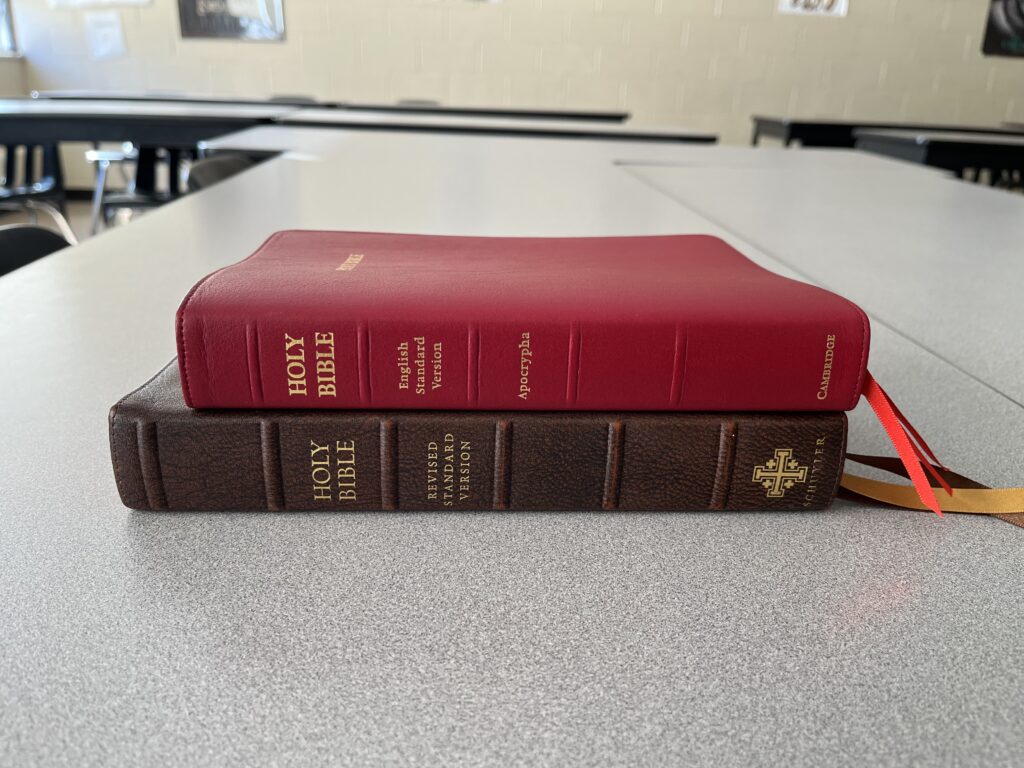
So, what do you get with this edition? Simply put, a bible with craftsmanship that is first rate and a text with plenteous references helps which make this an everyday, every situation bible that you can grow old with. This Diadem is printed and bound in The Netherlands by Royal Jongbloed. The size of this bible is roughly 6 ⅜ X 8 ⅞ with a thickness of just under 1 ½”. (To compare, It is slightly bigger than those old HarperOne NRSVCE Gift Bibles that came out ten or so years ago.) As you can see from the photos, I received the full red calfskin leather. (It also comes in black calfskin and calf split leather covers.) The calfskin is super soft while also being incredibly supple. I would say it is a tad bit softer than the Schuyler RSV in calfskin with more or less the same flexibility. With a weight of around 2.2 lbs., this bible is easy to hold and fits well in my hand for reading and teaching. The cover includes perimeter stitching (which I love!) as well as a liner that is edge-lined. Describing their edge-lined process, Cambridge notes that this sewn bible “is handmade in traditional edge-lined style, a craft process utilised to give both extra durability and strength to the binding and an aesthetically attractive suppleness to the cover–only binding by hand enables this effect to be achieved.” And it absolutely shows. It opens up perfectly flat immediately out of the box no matter which book you open it to. Three red satin ribbons are included which make a nice match to the color of the calfskin leather.
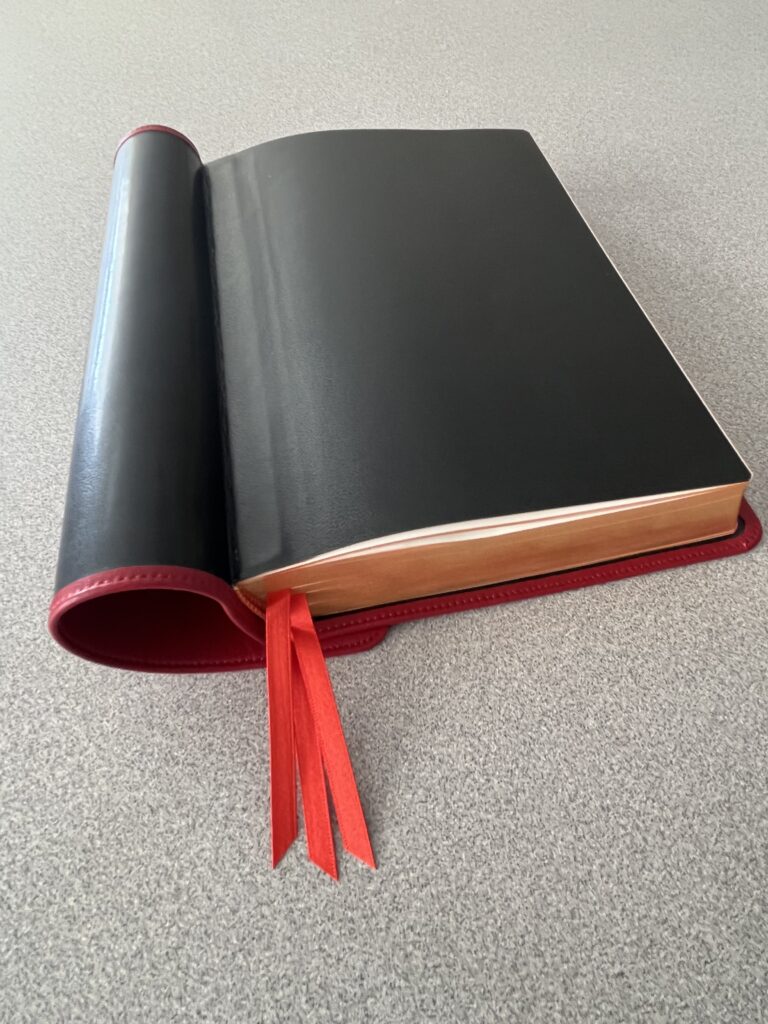
Opening up the bible you will find the 2016 text edition of the ESV along with the 2009 (2016) ESV Apocrypha/Deuterocanonicals, which are placed between the Old and New Testaments. This is not the anglicized ESV, but the one that contains American spelling. The text is laid out in double-column, paragraph format with center column cross-references. The paper clocks in at 32 gsm which, combined with the line-matching and slightly cream look to the paper, makes ghosting not an issue at all. The 8.1 lexicon font is printed dark and consistent throughout. One unique feature (which I have never had in a bible I used) is the red-letter text for the words of Jesus. Some people like red-letter bibles while others do not. I am pretty undecided one way or the other. I can tell you that the red is dark and not distracting at all. It also matches really well with the cover material and the art-gilt (red under gold) page edges.

If this bible were only a premium reading bible that would be sufficient, however, what raises it to the next level is that it contains the reference materials that allow it to be used for study and teaching as well. First up, the center column references are considerable, even spilling over to the right side of each page under the textual notes on some pages. References that are for the left column are left-justified and placed at the top, while those for the right column are right-justified and placed towards the bottom. There is an explanation on how to use these references in the preface. Once you get used to the system, it is quite easy to navigate. After the preface, you will find a list of Old and New Testament (including the Hasmonean) rulers, hence this edition being called the Diadem. What follows is the obligatory table of weights and measures before the scriptural text begins.
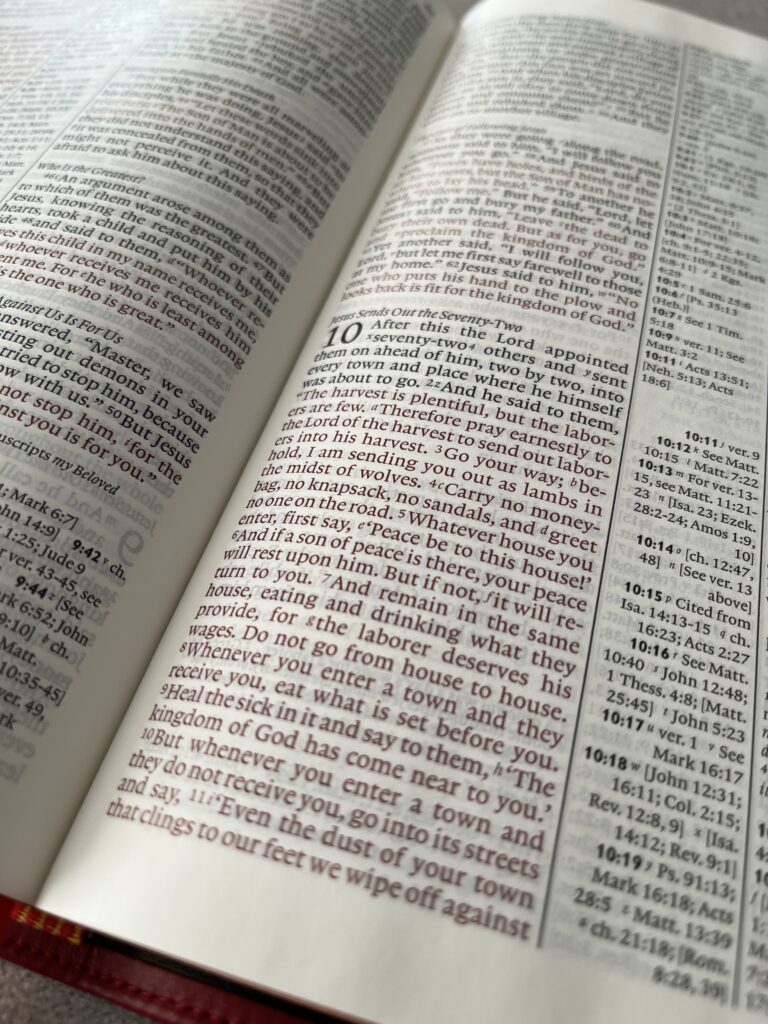
Two other important features are included, starting with the concordance. It is an 89 page, three column per-page concordance which I have been told has more entries than the Pitt Minion. There are somewhere around 3000 entries, which cover the main names and places found in the ESV translation. In addition, there are two sets of bible maps included in this edition with the Apocrypha. Between the Apocrypha and New Testament you will find three maps relevant to the Hellenistic/Maccabean period. These are identical to the ones found in the NRSV Reference edition. At the back of the bible, after the concordance, you will find 15 glossy Cambridge Bible Maps including an index. The glossy paper isn’t too shiny or thick to be a distraction. They fit this bible perfectly.
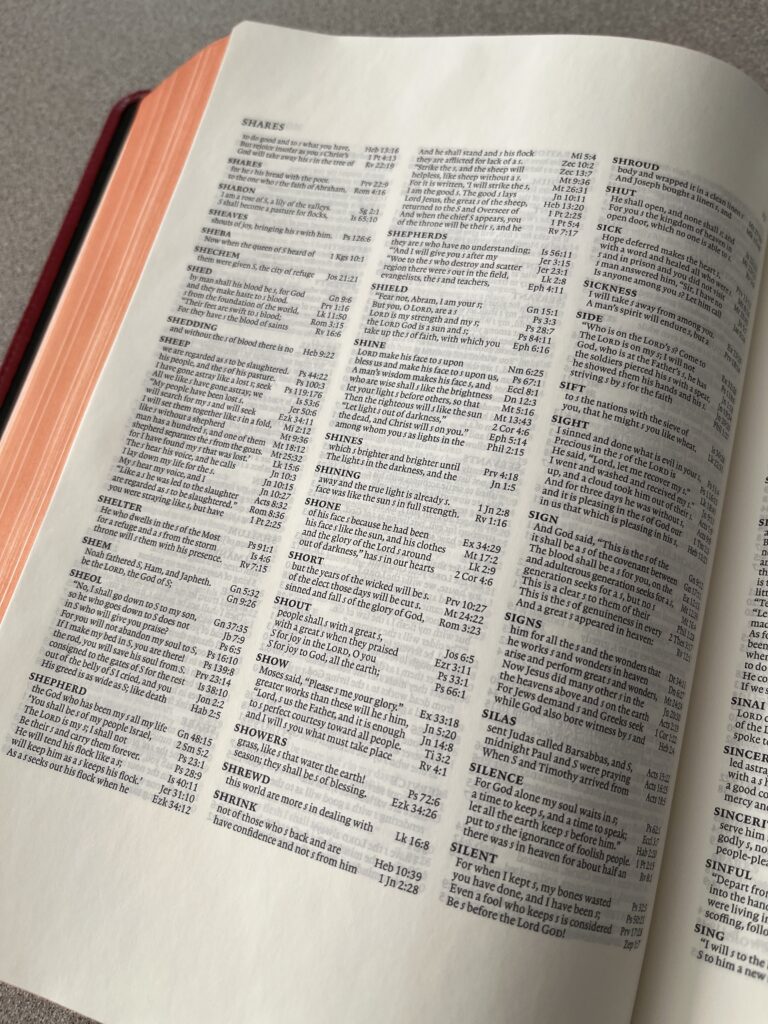
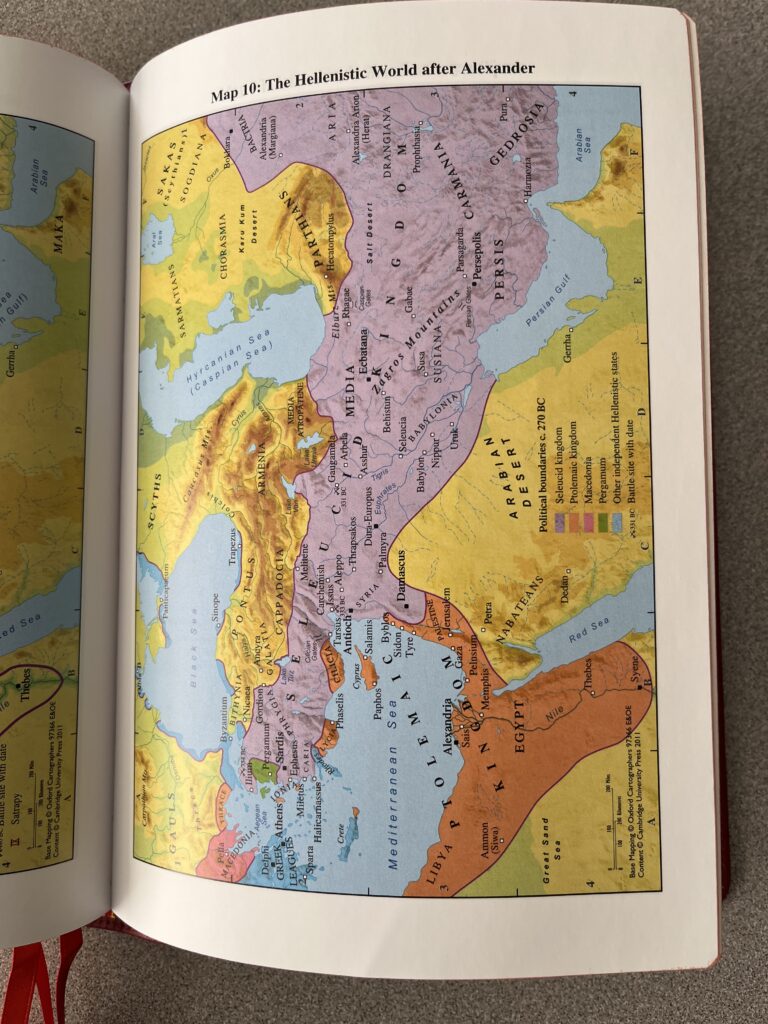
In conclusion, if you are looking for a truly premium edition of the ESV with Apocrypha/Deuterocanonicals look no further than the Cambridge Diadem ESV. While it is true that Cambridge will be publishing the ESVCE in their new Cornerstone line this coming summer (which I am looking forward to), it will most likely not have the same study references or premium leather cover and binding that is found in the Diadem. I also absolutely love the size of this bible, which is both portable and readable. Over the past year or so I have been primarily reading from the RSV/ESV lineage of bibles. When I received the Schuyler RSV in the fall of last year I was pretty certain that I had found my new every day bible. That changed with the arrival of the Diadem, which has now become a lead contender to be the everyday bible I use for prayer, study, and teaching. For more information on the Diadem, you can go to Cambridge’s Diadem page. This bible is currently on sale at Evangelical Bible for $247.00 (which includes the cost of shipping).
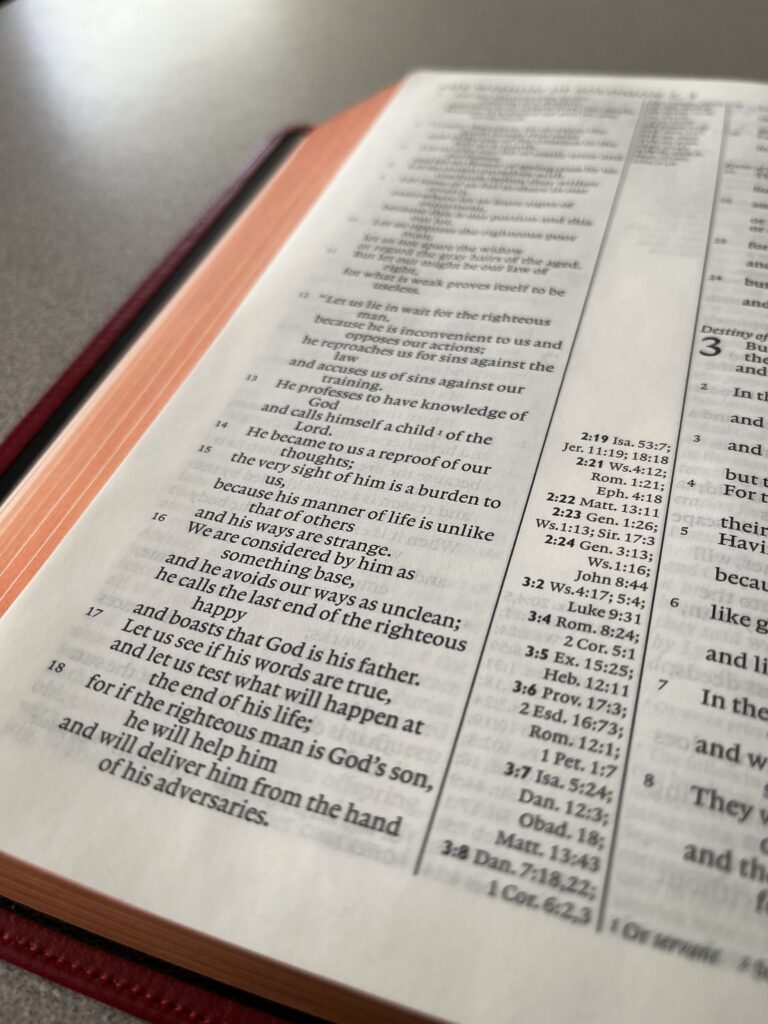
I want to thank Cambridge University Press for providing me a copy of the ESV Diadem w/ Apocrypha in exchange for an honest review.
Excellent review!
Excellent review of a beautiful text!
Yet, wait, here it is, it’s not a Catholic edition. No need to perseverate, though, I feel (and presume other Catholics also feel) like the lyrics of U2’s song based on Psalm 40, “How long, how long, how long?”
Yes
More info about the upcoming ESVCE Cornerstone is now available:
https://www.cambridge.org/us/bibles/bible-versions/english-standard-version/esv-ce-cornerstone-text-bible
$115 for “imitation leather” sounds completely insane as far as I’m concerned, making the Augustine Institute’s steep $65 price tag for their bonded leather seem like a steal in comparison. As for the main event, however, I’m happy for any users of the ESV-CE that they finally have a quality, real leather binding option from an esteemed publisher without having to go for a rebind to achieve it. Personally, 3/8″ ribbons and perimeter stitching on the cowhide edition rather than just on the imitation stuff would’ve been nice, but beggars can’t be choosers. I’m not particularly a fan of the ESV text, viewing it as a tad colorless compared to its predecessors in the RSV family and to the NRSV, but I’ll happily await the reviews this fall from here and elsewhere. I’ve seen enough Cambridge BIbles from other people to know it’ll be worth looking forward to.
You know, sometimes I look at their KJVs and imagine an alternative universe where we have dozens of choices for the “Douay-Rheims Bible from Cambridge University Press” in all manner of sizes, colors, leathers, and layouts!
This is definitely overpriced. They could have used this diadem layout for the esvce bible but instead they are going with the SPCK layout which has ghosting and no cross-references, just a bare bones layout at $115? Seriously the pricing is just too high for what you are getting.
Tim,
I’ve been looking for “the one”, and I think I’ve found it in Cambridge’s Diadem. It checks all the boxes for me personally especially since the ESV is my favorite translation. It’s portable, very readable, center column references, quality paper, dark black and red print…I think they hit the Goldielocks zone with this Bible. Once I saw the cornerstone catholic version would be gutted of cross references, I just ponied up the money and bought myself the Diadem with apocrypha in calf split . No regrets! It’s definitely worthy of a rebind with AE or some other bindery once the cover starts to go.
Rodolfo,
For me, it’s either this one or the Schuyler RSV. They are both fantastic.
It looks like you use the Augustine Institute ESV-CE a good bit as well. Any opinion on this one vs the AI one? I have the AI one now but am considering this.
Which revision of the ESV text is used in this one?
2016 Text
There recently was released a new illustrated version of the Latin Vulgate, a reprint from 1901.
I’d love to see Cambridge give the Douay the “New Cambridge Paragraph Bible” treatment. Verse-by-verse is just too difficult to read for more than a few minutes at a time.
Timothy,
Thanks for a great review. When it comes to craftsmanship and layout, the Diadem ESV with Apocrypha/Deuterocanonicals (with black calfskin leather) is exceptional. In my estimation, it falls second only to the Schuyler RSV, but it’s certainly a close second. One thing I appreciate most is that it is relatively compact and yet has a very readable font.
I’m also happy to see that Cambridge will now publish premium Catholic Bibles (and not just Bibles “with the Apocrypha”), beginning with the Cambridge Cornerstone.
Leighton,
I really can’t decide between the two. I love the size and references of the Diadem, while also thinking the translation is better than the RSV (most but not all of the time). The paper is also a bit better too. But the Schuyler is so much easier to read from. I love reading from the Schuyler. I also prefer the maps and glossary/concordance in the Schuyler. But either way, they are both superb bibles, the best that I have had in 15 years.
Timothy,
Absolutely agree. I go back and forth for the reasons you stated. For the most part, I prefer the ESV translation with a few exceptions.
Ultimately, I prefer the Schuyler mostly for its larger font (middle-aged eyes!). If the Diadem’s font was just a tad larger, it would probably be a shoo-in.
They’re both truly beautiful bibles.
For what it’s worth, I emailed EvangelicalBibles.com to ask about a Schuyler ESV with Apocrypha, and there may be one coming next year:
“There are plans for a Schuyler Quentel ESV with Apocrypha in 2024, but we don’t have a date for it yet. Stay tuned.”
Also:
“Schuyler does not publish any other Bibles with the Apocrypha at this time, but a KJV with Apocrypha is also likely, after the ESV.”
That is interesting. And it makes sense to do a KJV with Apocrypha. Thanks for the info Matthew!
Hi Timothy:
Thanks for your review. Does the ESV DIADEM W/ APOCRYPHA (RED CALFSKIN LEATHER) include the changes made to the deuterocanonical in the catholic edition. Thanks again
Ralph,
It uses the 2017 edition, which is different than the original 2009 ESV apocrypha.
Hi Timothy
Is this 2017 edition of the apocrypha similiar to or the same as the deuterocanonical texts used in the ESV Catholic edition? Before investing in a non Roman Catholic premium bible, I would want the translation to be as theologically Catholic as possible. By in large, I like what I have read of the ESV so far, however I haven’t read any of its apocrypha to make the same determination. I would like a premium ESV bible, that is why I haven’t purchased the Catholic edition. Thanks
Ralph,
I am trying to find where I read about this issue, but I can’t see where that was. I think they were minor, perhaps the difference being with the book of Esther. This li k might be helpful:
http://catholicbibletalk.com/2020/08/qa-on-the-esvce-w-mark-giszczak-s-s-l-ph-d/
Hi Timothy:
Which do you believe is a better translation in terms of readability, accuracy and fidelity to Roman Catholic teachings, the ESV Catholic Edition or the New Catholic Bible (NCB) published by the Catholic Book Publishing Company?
Thanks
Anon,
I have not spent any time in the NCB so I am not able to answer the question. Both are approved translations so I don’t think you will find anything heretical in them. I’d encourage you to check out biblegateway.com where you can compare the two translations.
Anonymous,
I spend a lot of time in both translations and find them both to be very good— very readable, accurate, and faithful. The ESVCE is more on the formal equivalence side, with the NCB slightly less formal, but still on that side of the translation spectrum. And in rare instances, the NCB is more literal (e.g. John 2:4) than the ESVCE. Both are considered very reliable and trustworthy, though.
The NCB is comparable to the NABRE, in my opinion, though I personally find it flows better and hits the mark more often. What stands out most to me about the NCB, and the biggest reason I still use it a lot (despite my preference for the ESVCE translation) is that the notes are so good and thorough. In my opinion, they’re much better than the NABRE’s notes. Of course, presently, there’s no ESVCE with doctrinal and historical notes available.
I tend to use the NCB more for study, and the ESVCE more for lectio divina.
Thanks so much for the nice review. I like the bible very much, but have not purchased it because I am not sure if the font size is ok for me. Is there a way to check before buying? like font sample sheet
Helena,
Follow this link for more info:
https://biblebuyingguide.com/cambridge-esv-diadem-in-black-calfskin/
How is the thickness compared with Schuyler Quintel? It looks like the same.
The Diadem is not as thick. Overall, the Diadem is a more portable size compared to the Schuyler.
Not sure where to post this, but I just got my copy of the SPCK’s ESV with Apocrypha – and comparing it to the ESV Catholic Edition, I realized that SPCK’s ESV with Apocrypha actually has the ESV-CE text for the deuterocanonicals (!) – i.e. it follows the 2017 ESV-CE’s texts for Tobit, Esther and Sirach, rather than the Apocrypha published by Oxford back in 2009. So essentially, SPCK’s ESV with Apocrypha is very close to the ESV-CE, just minus the few changes made to the protocanonical books of the OT and NT.
Does anyone know which texts the Cambridge’s edition of the ESV with Apocrypha used for the deuterocanonicals – the 2009 Oxford version or the 2017 ESV-CE version? Thanks!
Simon,
2009 Oxford version.
Thanks all for the review and comments here: very helpful in deciding to get the Diadem!
I wanted to clarify the source of the Apocrypha given that the above comment was one drawback I had that has since been resolved—looks like Cambridge is using the work done for the ESV-CE Deuterocanonicals (including the longer Tobit). From the Preface to the Apocrypha:
“We are pleased to acknowledge further that the bulk of this edition is an adaptation of the ESV with Apocrypha first published by Oxford University Press in 2009. That edition used the Revised Standard Version (RSV) Apocrypha (1971) and the RSV Expanded Apocrypha (1977) as its base. In 2016, a team of Catholic and Protestant scholars from the United Kingdom, Australia, India, and the United States completed a final revision of Tobit, 1–2 Maccabees, Wisdom of Solomon, Sirach, Judith, Baruch, and the Greek additions to Esther and Daniel, thus creating this present edition of the ESV Apocrypha.” (xiv)
“The ESV Apocrypha used the Göttingen Septuagint as its textual base, with the following exceptions: 4 Maccabees was translated from Rahlfs’ Septuagint and 2 Esdras was translated from the 1983 Vulgate published by the German Bible Society. In the special case of Tobit, the translators used the longer Greek text (Sinaiticus) supplemented by the shorter Greek text (Vaticanus) and the Old Latin version at points where the longer text lacks some verses (4:7–18; 13:6b–10a).” (xv)
Adding on to this from my own studies, which could be wrong since I don’t own the ESV Diadem and have only glanced at some pages in people’s videos, the cross-references in the Deuterocanon/Apocrypha appear to be identical to the cross-references used in the NRSV Reference Bible with Apocrypha by Cambridge. I assume this is because it’s still Cambridge’s references.
Thank you all. I’m edified to know the apocrypha will be same as the ESV-CE. I wanted to pass on the deal I found on Amazon currently for the black calfsplit version:
https://www.amazon.ca/dp/1009087649?ref_=pe_125682630_1045605200_i_fed_asin_title
A bargain for 86 USD. Even with the 2025 changes in the ESV text incoming. For the same price, I was debating between the imprimatur of the cornerstone and the construction/features of the diadem. A bit like choosing between the Catholic girl and the attractive protestant. Lord have mercy.
Hope the deal works for y’all.
The black calfskin w/ apocrypha currently has a 15% off coupon on Amazon. You can snag it for about $200 with shipping.